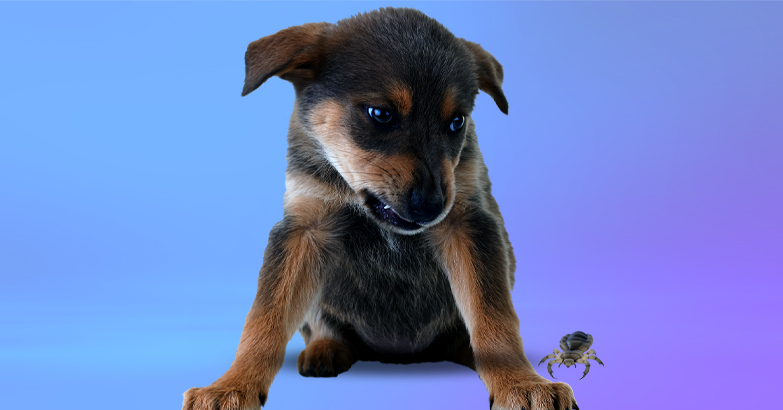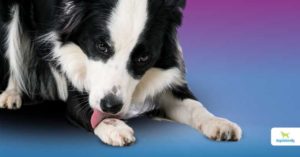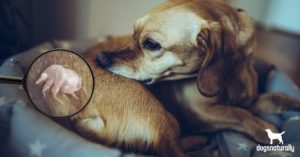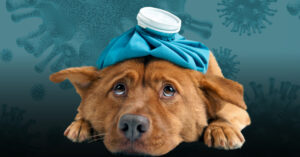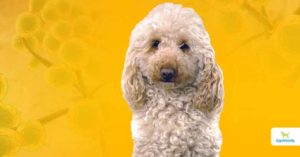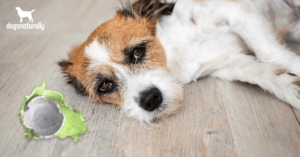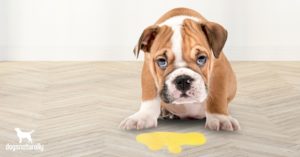There are plenty of parasites that infest dogs. Just the thought of some of them can cause you to twitch and squirm … and lice are one of those parasites. So let’s take a look.
Can dogs get lice? And if so, what can you do about it?
Can Dogs Get Lice?
Yes, dogs can get lice. These small, wingless insects can infest a dog’s fur and cause itching and irritation.
What Do Dog Lice Look Like?
Dog lice are about the size of a sesame seed and you can see them with the naked eye near the hair roots. You can also see nits (lice eggs) that may be firmly attached to the hair shafts. Nits are usually oval-shaped and can be light brown or transparent in color.
There are two main types of dog lice:
- Chewing or Biting Lice
- Sucking Lice
Both types of lice can multiply quickly and cause significant discomfort for your dog.
Chewing Lice on Dogs
The main species of chewing lice that affects dogs in North America is Trichodectes canis. Another species, Heterodoxus spiniger, is found on wild canids like coyotes, foxes and wolves in North America but not (yet) on domestic dogs.
Chewing lice or biting lice have large heads and mandibles (jaws). They’re aptly named because they chew on the dog’s skin and hair to feed. Dogs with chewing lice may scratch excessively, which can cause hair loss. They may also develop sores or skin infections due to constant scratching.
Sucking Lice On Dogs
The species of sucking lice that affects dogs is called Linognathus setosus. Sucking lice have narrow heads to suck the dog’s blood.
Dog Lice Symptoms
If you see some of the following symptoms, it’s a good idea to check your dog for lice.
- Intense itching
- Dry coat
- Hair loss, especially around neck, ears, rectal area or groin
- In severe lice infestations, your dog could develop anemia
- Tapeworms, which chewing lice can transmit to your dog
Where To Look For Lice On Dogs
Here are some common places for lice on dogs:
- Around the ears, where lice are protected.
- Neck and collar, where they have easy access to the dog’s skin and blood supply.
- Groin and underbelly, where it’s warm and moist.
- Base of the tail, where the fur is dense.
- Armpits and legs, where they’re protected and can feed.
- Back and sides, where they can easily move and feed.
You can examine your dog for lice by parting the fur to expose the skin, then closely inspect each area. Again, they’re tiny, sesame seed-sized insects crawling near the hair roots. Orf you may see nits along the hair shafts.
How Do Dogs Get Lice?
Dogs can get lice from an infested dog or by coming into contact with lice-infested bedding, grooming tools, or shared toys. Lice can easily move from one dog to another in environments where dogs mingle closely, such as kennels or dog parks.
Can Humans Get Dog Lice?
No, humans cannot get dog lice. The lice species that affect dogs can’t survive on human skin. Dog lice need a dog’s specific body chemistry to survive and reproduce.
Can Dogs Get Lice From Humans?
No, dogs cannot get human lice. But if your dog has lice, you’ll want to isolate him from other pets in the home to prevent spreading lice to other animals.
Conventional Dog Lice Treatment
When it comes to treating dog lice, many pet owners opt for conventional treatments. However, most over-the-counter shampoos, sprays, and topical treatments use insecticides to target lice and their eggs. So yes, they may kill the lice, but these harmful products can be absorbed by your dog’s skin. Most are neurotoxins that can produce serious side effects like seizures or tremors … and itching!
Natural Dog Lice Treatment
Fortunately, there are several natural remedies you can use. And remember, It’s always best to feed a fresh, whole food diet that supports your dog’s digestive and immune health, to help fight off parasites like lice.
We’ve included a recipe for a safe dog shampoo for lice. But first, here’s how to get rid of dog lice at home fast.
- Neem Oil: It has insecticidal properties and can suffocate and kill lice and dog lice eggs. Dilute 1 part neem oil to 10 parts of a carrier oil like almond or olive oil, and apply it to your dog’s coat. Leave it on for a few hours, then wash it off using a natural, organic shampoo.
- Neem Oil Shampoo: You can buy a good quality organic neem oil shampoo, or use the recipe below recipe for a neem-based dog lice shampoo.)
- Regular Grooming: Inspect for signs of lice every time you brush your dog to prevent infestations and catch them early if they occur.
- Apple Cider Vinegar: ACV has antimicrobial properties and can create an unfavorable environment for lice. Dilute it with water and use it as a final rinse after shampooing your dog to discourage lice.
- Diatomaceous Earth: This fine powder from fossilized algae can be sprinkled on your dog’s coat and rubbed into the fur in problem areas (be careful around eyes, nose and mouth so your dog doesn’t inhale it). DE works by dehydrating lice, causing them to die. Be sure to use food-grade diatomaceous earth.
- Essential Oil Blend: Make this natural repellent by combining essential oils known for their insect-repellent properties. Mix 2 drops each of lavender, rosemary, and eucalyptus essential oils per 1 oz carrier oil in a spray bottle. Spritz your dog’s coat, avoiding his face, and brush through to distribute the mixture.
- Wash Bedding: Carefully remove infested bedding and rugs. Place anything you don’t have time to wash immediately in a carefully sealed trash bag, to confine the lice and stop the spread. When you’re ready to wash, use the hottest temperature wash cycle. Non-toxic laundry soaps will kill lice and their eggs. Then dry on the hottest heat setting. To prevent reinfestation, store clean bedding in garbage bags for a few days to ensure lice or eggs have died off. It’s also a good idea to clean the washing machine on an empty cycle with hot water and detergent.
Recipe: Safe Shampoo For Dog Lice
Ingredients
- 1 cup of water
- 1/4 cup of mild liquid castile soap
- 2 T of neem oil
- 1 T of almond oil or olive oil
- 10 drops of rosemary essential oil
- 10 drops of lavender essential oil
Directions
Combine the water and castile soap. Add the neem oil, almond or olive oil, and essential oils to the mixture. Stir gently to blend the ingredients. Transfer the mixture into a clean, empty shampoo bottle or a mason jar with a tight lid.
Wet your dog’s coat with warm water, then apply the shampoo starting from the neck and working your way down to the tail. Massage it into the skin and coat, focusing on areas where lice are most likely to be found. Leave the shampoo on your dog for a few minutes before rinsing.
After rinsing, use a fine-toothed lice comb to comb through your dog’s fur to remove any lice or nits that may still be there. Wipe the comb often with a clean cloth. Shampoo and comb your dog as needed until the lice are eliminated.
When you know what to look for, you can take the necessary steps to get rid of lice on your dog … and avoid them in the future.

